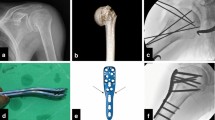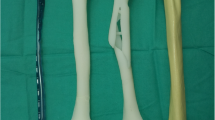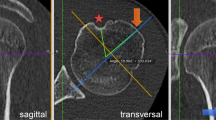Abstract
Introduction
We compared the angle of the humerus and plate and to assess compatibility of a plate to the proximal humerus using three-dimensional (3D) printed models.
Materials and methods
A total of 120 cases were included, who underwent anteroposterior shoulder radiographs. From these, 30 cases with 3D shoulder computed tomography scans were randomly selected to print 3D model. The lateral angle between the lateral cortex of the humeral shaft and lateral border of the greater tuberosity (GT), neck-shaft angle, and height from the most proximal point of the GT to the angular point were measured. When the plates were applied on the 3D models, the gap from the most proximal point of the GT to the proximal rim of the plate was measured.
Results
The mean lateral angle in plain radiographs was 12.9 ± 2.2° and height from the most proximal point of the GT to the angular point was 44.4 ± 4.7 mm. The bending angles of the three plates were 8° and 10°. Height from the proximal rim of the plate to the bending point was 42.4, 42.0 and 43.8 mm. In 98% of cases, the lateral angle of the humerus was larger than all three plates. In 43% of cases, height of the GT was smaller than height of plates. When plates were applied to the 3D model, the mean gap from GT to plate was 4.8 ± 2.8 mm.
Conclusions
There was large variation in the lateral angle of the proximal humerus, which was not correlated with the neck-shaft angle. The lateral angle of the humerus was larger than the plates and prone to varus reduction and medial collapse.
Level of evidence or clinical relevance
Basic science study.








Similar content being viewed by others
References
Laux CJ, Grubhofer F, Werner CML, Simmen HP, Osterhoff G (2017) Current concepts in locking plate fixation of proximal humerus fractures. J Orthop Surg Res 12(1):137. https://doi.org/10.1186/s13018-017-0639-3
Baron JA, Barrett JA, Karagas MR (1996) The epidemiology of peripheral fractures. Bone 18(3 Suppl):209S-213S. https://doi.org/10.1016/8756-3282(95)00504-8
Bahrs C, Stojicevic T, Blumenstock G, Brorson S, Badke A, Stockle U, Rolauffs B, Freude T (2014) Trends in epidemiology and patho-anatomical pattern of proximal humeral fractures. Int Orthop 38(8):1697–1704. https://doi.org/10.1007/s00264-014-2362-6
Ring D (2007) Current concepts in plate and screw fixation of osteoporotic proximal humerus fractures. Injury 38(Suppl 3):S59-68. https://doi.org/10.1016/j.injury.2007.08.013
Chalmers PN, Slikker W 3rd, Mall NA, Gupta AK, Rahman Z, Enriquez D, Nicholson GP (2014) Reverse total shoulder arthroplasty for acute proximal humeral fracture: comparison to open reduction-internal fixation and hemiarthroplasty. J Shoulder Elbow Surg 23(2):197–204. https://doi.org/10.1016/j.jse.2013.07.044
Gupta AK, Harris JD, Erickson BJ, Abrams GD, Bruce B, McCormick F, Nicholson GP, Romeo AA (2015) Surgical management of complex proximal humerus fractures-a systematic review of 92 studies including 4500 patients. J Orthop Trauma 29(1):54–59. https://doi.org/10.1097/BOT.0000000000000229
Spross C, Platz A, Erschbamer M, Lattmann T, Dietrich M (2012) Surgical treatment of Neer Group VI proximal humeral fractures: retrospective comparison of PHILOS(R) and hemiarthroplasty. Clin Orthop Relat Res 470(7):2035–2042. https://doi.org/10.1007/s11999-011-2207-1
Noh YM, Kim DR, Kim CH, Lee SY (2018) Minimally invasive percutaneous plate osteosynthesis via a deltoid splitting approach with strut allograft for the treatment of displaced 3- or 4-part proximal humeral fractures. Clin Shoulder Elbow 21(4):220–226. https://doi.org/10.5397/cise.2018.21.4.220
Sperling JW (2019) Pearls and tips in shoulder arthroplasty. Clin Orthop Surg 11(3):258–264
Beeres FJP, Quaile OM, Link BC, Babst R (2019) Reduction techniques for minimally invasive stabilization of proximal humeral fractures. Oper Orthop Traumatol 31(1):63–80. https://doi.org/10.1007/s00064-018-0586-0
Lee SJ, Hyun YS, Baek SH (2019) Strut support with tricortical iliac allografts in unstable proximal humerus fractures: Surgical indication and new definition of poor medial column support. Clin Shoulder Elbow 22(1):29–36. https://doi.org/10.5397/cise.2019.22.1.29
Walsh S, Reindl R, Harvey E, Berry G, Beckman L, Steffen T (2006) Biomechanical comparison of a unique locking plate versus a standard plate for internal fixation of proximal humerus fractures in a cadaveric model. Clin Biomech 21(10):1027–1031. https://doi.org/10.1016/j.clinbiomech.2006.06.005
Nourbakhsh A, Hirschfeld AG, Dhulipala S, Hutton W, Ganey T, Lozada L, Schlatterer D, Lourie GM (2019) Biomechanical comparison of fixed- versus variable-angle locking screws for distal humerus comminuted fractures. Clin Orthop Surg 11(3):302–308
Launonen AP, Lepola V, Flinkkila T, Laitinen M, Paavola M, Malmivaara A (2015) Treatment of proximal humerus fractures in the elderly: a systemic review of 409 patients. Acta Orthop 86(3):280–285. https://doi.org/10.3109/17453674.2014.999299
Owsley KC, Gorczyca JT (2008) Fracture displacement and screw cutout after open reduction and locked plate fixation of proximal humeral fractures [corrected]. J Bone Joint Surg Am 90(2):233–240. https://doi.org/10.2106/JBJS.F.01351
Hirschmann MT, Fallegger B, Amsler F, Regazzoni P, Gross T (2011) Clinical longer-term results after internal fixation of proximal humerus fractures with a locking compression plate (PHILOS). J Orthop Trauma 25(5):286–293. https://doi.org/10.1097/BOT.0b013e3181f2b20e
Geβmann J, Königshausen M, Schildhauer TA, Seybold D (2019) Periprsthetic humeral fractures: from osteosynthesis to prosthetic replacement. Oper Orthop Traumatol 31(2):84–97. https://doi.org/10.1007/s00064-019-0591-y
Chen JL, Chang FC, Lin SJ, Chuang PY, Peng KT, Huang KC, Huang TW (2018) The outcome of surgical management of proximal humeral fractures using locking plates: comparison between locking plates with different geometry. J Shoulder Elbow Surg 27(12):2159–2166. https://doi.org/10.1016/j.jse.2018.05.033
Court-Brown CM, McQueen MM (2004) The impacted varus (A2.2) proximal humeral fracture: prediction of outcome and results of nonoperative treatment in 99 patients. Acta Orthop Scand 75(6):736–740. https://doi.org/10.1080/00016470410004111
Kwak JY, Park HB, Jung GH (2016) Accurate application of a precontoured-locking plate for proximal humeral fractures in Asians: a cadaveric study. Arch Orthop Trauma Surg 136(10):1387–1393. https://doi.org/10.1007/s00402-016-2538-1
Mardis NJ (2018) Emerging technology and applications of 3D printing in the medical field. Mo Med 115(4):368–373
Tack P, Victor J, Gemmel P, Annemans L (2016) 3D-printing techniques in a medical setting: a systematic literature review. Biomedical engineering online 15(1):115. https://doi.org/10.1186/s12938-016-0236-4
You W, Liu LJ, Chen HX, Xiong JY, Wang DM, Huang JH, Ding JL, Wang DP (2016) Application of 3D printing technology on the treatment of complex proximal humeral fractures (Neer3-part and 4-part) in old people. Orthop Traumatol Surg Res 102(7):897–903. https://doi.org/10.1016/j.otsr.2016.06.009
Yushkevich PA, Piven J, Hazlett HC, Smith RG, Ho S, Gee JC, Gerig G (2006) User-guided 3D active contour segmentation of anatomical structures: significantly improved efficiency and reliability. Neuroimage 31(3):1116–1128. https://doi.org/10.1016/j.neuroimage.2006.01.015
Ravindra A, Roebke A, Goyal KS (2017) Cadaveric Analysis of Proximal Humerus Locking Plate Fit: Contour Mismatch May Lead to Malreduction. J Orthop Trauma 31(12):663–667. https://doi.org/10.1097/BOT.0000000000000997
Agudelo J, Schurmann M, Stahel P, Helwig P, Morgan SJ, Zechel W, Bahrs C, Parekh A, Ziran B, Williams A, Smith W (2007) Analysis of efficacy and failure in proximal humerus fractures treated with locking plates. J Orthop Trauma 21(10):676–681. https://doi.org/10.1097/BOT.0b013e31815bb09d
Jeong J, Jung HW (2015) Optimizing intramedullary entry location on the proximal humerus based on variations of neck-shaft angle. J Shoulder Elbow Surg 24(9):1386–1390. https://doi.org/10.1016/j.jse.2015.01.016
Jeong J, Bryan J, Iannotti JP (2009) Effect of a variable prosthetic neck-shaft angle and the surgical technique on replication of normal humeral anatomy. J Bone Joint Surg Am 91(8):1932–1941. https://doi.org/10.2106/JBJS.H.00729
DeLude JA, Bicknell RT, MacKenzie GA, Ferreira LM, Dunning CE, King GJ, Johnson JA, Drosdowech DS (2007) An anthropometric study of the bilateral anatomy of the humerus. J Shoulder Elbow Surg 16(4):477–483. https://doi.org/10.1016/j.jse.2006.09.016
Fankhauser F, Boldin C, Schippinger G, Haunschmid C, Szyszkowitz R (2005) A new locking plate for unstable fractures of the proximal humerus. Clin Orthop Relat Res 430(430):176–181. https://doi.org/10.1097/01.blo.0000137554.91189.a9
Nho SJ, Brophy RH, Barker JU, Cornell CN, MacGillivray JD (2007) Innovations in the management of displaced proximal humerus fractures. J Am Acad Orthop Surg 15(1):12–26. https://doi.org/10.5435/00124635-200701000-00003
Gardner MJ, Boraiah S, Helfet DL, Lorich DG (2008) Indirect medial reduction and strut support of proximal humerus fractures using an endosteal implant. J Orthop Trauma 22(3):195–200. https://doi.org/10.1097/BOT.0b013e31815b3922
Robinson CM, Wylie JR, Ray AG, Dempster NJ, Olabi B, Seah KT, Akhtar MA (2010) Proximal humeral fractures with a severe varus deformity treated by fixation with a locking plate. J Bone Joint Surg Br 92(5):672–678. https://doi.org/10.1302/0301-620X.92B5.22849
Butler MA, Chauhan A, Merrell GA, Greenberg JA (2018) Establishing the appropriate position of proximal humerus locking plates: a cadaveric study of five plating systems and their anatomic reference measurements. Shoulder Elbow 10(1):40–44. https://doi.org/10.1177/1758573217704816
Fletcher JWA, Windolf M, Richards RG, Gueorguiev B, Buschbaum J, Varga P (2019) Importance of locking plate positioning in proximal humeral fractures as predicted by computer simulations. J Orthop Res 37(4):957–964. https://doi.org/10.1002/jor.24235
Acknowledgements
This work was supported by the ‘Technology Innovation Program’ (20000397, Development of 2 Track Customized 3D Printing Implant Manufacturing and Commercializing Techniques for Complex Bone Fractures) funded by the Ministry of Trade, Industry & Energy (MOTIE), Korea. None of the researchers or an affiliated institute has received (or agreed to receive) from a commercial entity something of value (exceeding the equivalent of US$500) related in any way to this manuscript or research. The name of the Approval was ̒Comparison of the anatomical plate using 3D printerʼ (PIRB-20200305-005) at 5 Mar 2020.
Funding
There is a funding source (Government).
Author information
Authors and Affiliations
Corresponding author
Ethics declarations
Conflict of interest
The authors declare that they have no conflict of interest.
Ethical approval
This article was approved from the Institutional Review Board.
Additional information
Publisher's Note
Springer Nature remains neutral with regard to jurisdictional claims in published maps and institutional affiliations.
Rights and permissions
About this article
Cite this article
Kim, H., Chung, YG., Jang, J.S. et al. Why locking plates for the proximal humerus do not fit well. Arch Orthop Trauma Surg 142, 219–226 (2022). https://doi.org/10.1007/s00402-020-03676-0
Received:
Accepted:
Published:
Issue Date:
DOI: https://doi.org/10.1007/s00402-020-03676-0




